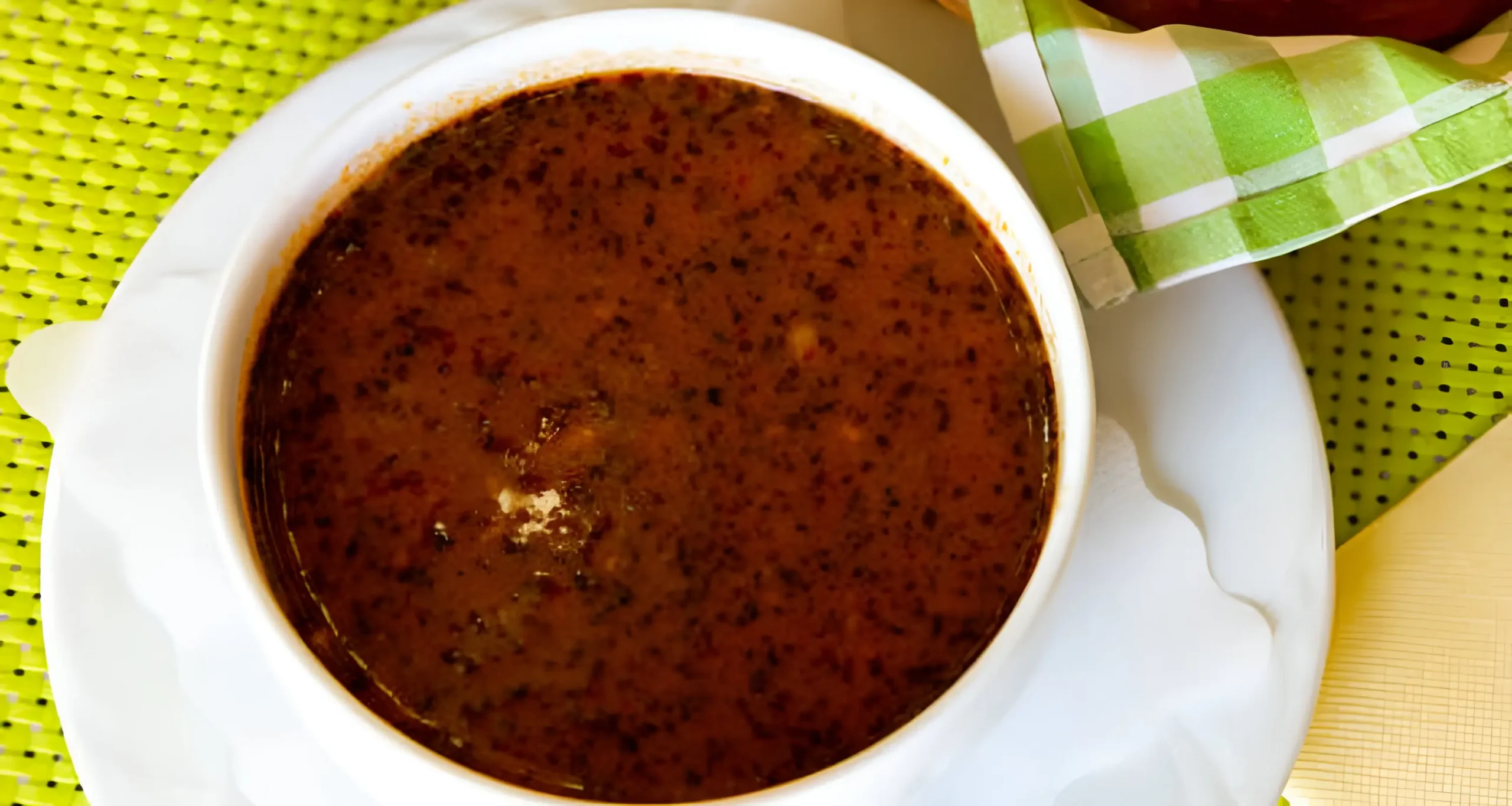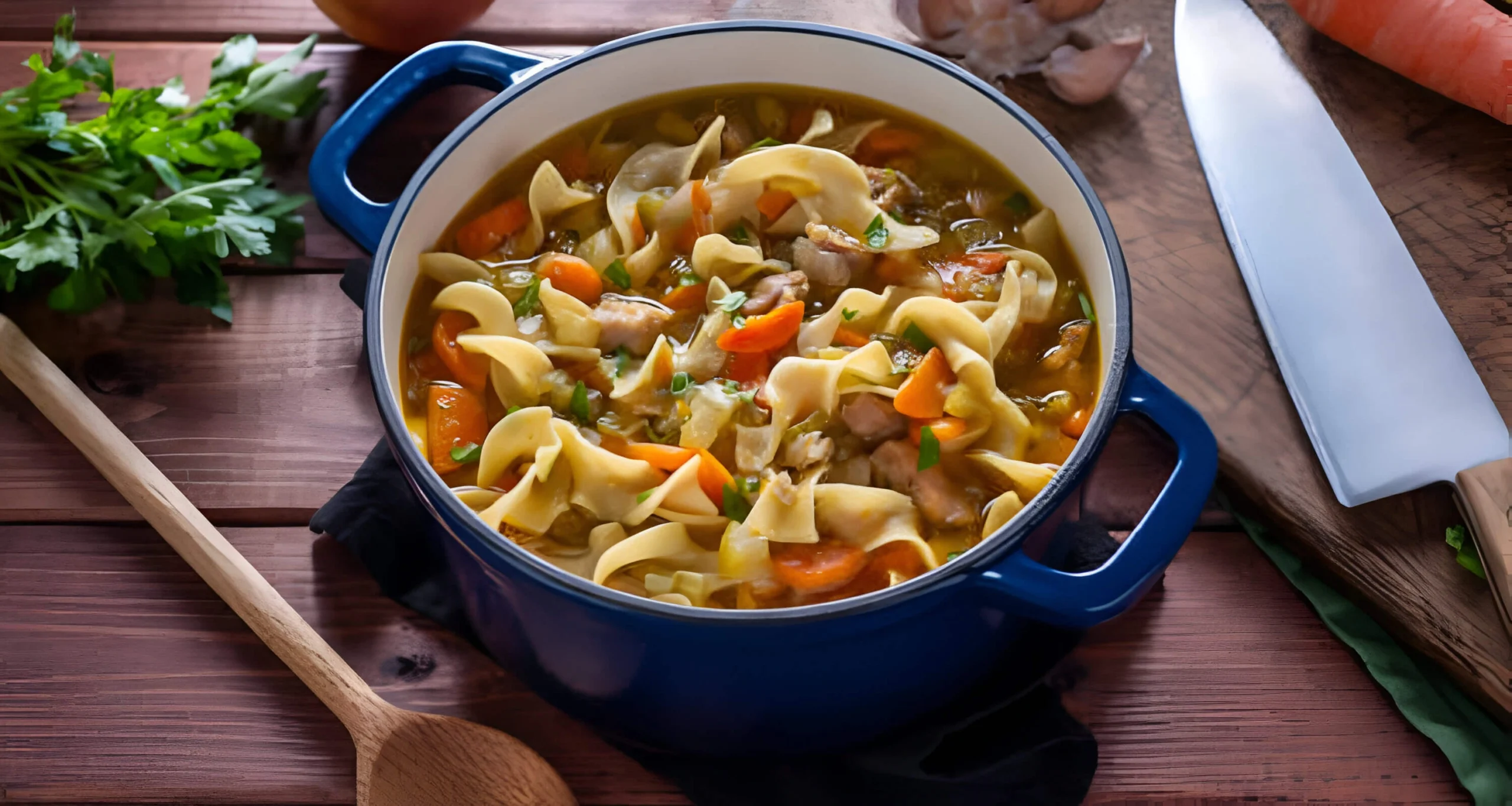Bone Broth Soup: 7 Health Benefits You Need to Know

Do you remember the smell of a slow-simmering pot in a cozy kitchen? That smell often brought comfort after a long day or when you were sick. Bone Broth Soup offers that same comfort and real nutrition you can make at home.
This article highlights seven key health benefits of bone broth. You’ll learn how to make homemade bone broth soup easily. It’s great for joint support, gut health, and recovery.
Bone broth soup is loved in many diets because it’s easy to make and full of nutrients. You can use chicken bones, beef marrow, or mixed bones. This guide will show you how to make it and use it in your meals.
Key Takeaways
- Bone Broth Soup delivers collagen, minerals, and amino acids that support joints, gut health, and recovery.
- This guide covers seven bone broth health benefits backed by research and practical use.
- You’ll find clear instructions for making homemade bone broth soup, including slow cooker and pressure-cooker options.
- A simple bone broth soup recipe makes it easy to add nutrient-rich broth to your weekly meals.
- The article includes nutrition details, safety advice, and variations for different tastes and needs.
What is Bone Broth Soup and Why It Matters
Bone broth soup is a tasty, nutritious liquid. It’s made by simmering animal bones with water, onions, carrots, and celery. You also add herbs, salt, and a bit of vinegar or lemon.
The slow cooking process, lasting from 4 to 48 hours, releases important nutrients. These include gelatin, collagen, and minerals like calcium and magnesium.
Definition and basic ingredients of bone broth soup
It starts with bones from chicken, beef, pork, or fish. Bones with joints and marrow are best for collagen. Adding aromatics and acid boosts flavor.
When you make it at home, you can choose the quality of ingredients. You also have control over both the cooking time and the amount of salt used. This affects the soup’s taste and nutritional value.
How bone broth differs from traditional stock and bone broth concentrates
Bone broth and stock differ in cooking time and purpose. Stock is cooked for 1 to 6 hours for flavor. Bone broth is cooked longer to get more gelatin and collagen.
Stock often uses meaty bones, while broth uses larger, joint-rich bones. Bone broth concentrates and powders are convenient but may have added ingredients. They can be less nutritious than homemade broth.
Why bone broth is gaining popularity in the United States
More people are interested in bone broth due to its health benefits. It’s also easier to make with slow cookers and pressure cookers. Brands like Kettle & Fire and Bonafide Provisions make it easy to find in stores.
Knowing the differences between homemade and store-bought bone broth helps you choose. It’s about finding the right balance between taste, nutrition, and convenience.
Top Health Benefits of Bone Broth Soup
Bone broth soup benefits many areas of health, like joints, digestion, and immune recovery. Here’s a guide on why and how to add bone broth to your diet.
1. Joint support with collagen and gelatin
Collagen and gelatin in bone broth help keep cartilage healthy and joints flexible. They offer amino acids similar to those in clinical collagen supplements. For joint health, bone broth is a tasty, food-based option to consider.
2. Gut health and digestion
Gelatin, glutamine, and glycine in bone broth aid digestion by protecting the gut lining. If you have bloating or irregular bowel movements, warm broth can help soothe your gut.
3. Immune support and nutrient density
Bone broth is packed with electrolytes, trace minerals, and protein, supporting hydration and recovery during illness. Its mild taste makes it perfect for adding veggies, garlic, and herbs, boosting vitamin and immune support.
4. Skin, sleep, and weight-management benefits
Collagen in bone broth helps skin stay elastic and aids in wound healing. Glycine promotes better sleep and mental calm. Low-calorie broth meals can help manage weight by keeping you full without adding calories.
5. How strong is the evidence?
Some benefits, like collagen for joint comfort, have solid clinical backing. Additional benefits are suggested by traditional use and current research, such as bone broth’s potential support for gut health. Always consult a healthcare provider before using broth for medical conditions.
Quick summary
- Joint support: bone broth provides collagen and gelatin, which help maintain healthy cartilage.
- Gut support: bone broth helps soothe the gut lining through its gelatin and amino acids.
- Immune and recovery: it provides minerals, protein, and hydration for recovery.
- Extra perks: it’s good for skin, sleep, and appetite control.
How Bone Broth Soup Supports Joint and Bone Health
Bone broth is great for joint health. It’s made by simmering bones for a long time. This process releases collagen and gelatin, which are good for your body.
It also has amino acids like glycine and proline. These help your connective tissues. You’ll also get some calcium and phosphorus, and fat-soluble nutrients from the marrow.
Key nutrients and what they do
Collagen is important for cartilage, tendons, and ligaments. When bones simmer, they release collagen peptides. Your body can use these for repair and maintenance.
Gelatin is cooked collagen that turns gel-like when it cools. It gives your body amino acids that help your joints and gut lining.
Glucosamine and chondroitin are in cartilage and can get into broth. But the amounts vary by recipe and cooking time. Homemade broth might not have enough for clinical doses.
What research says
Studies show collagen hydrolysate can reduce joint pain and discomfort. These studies use about five grams of collagen per day. These studies can be found in publications such as the British Journal of Nutrition.
But, broth might not have enough glucosamine and chondroitin for these benefits. Systematic reviews are good for a deeper look. They summarize many studies and compare their results.
How to use broth for joint support
Drink one to two cups of collagen bone broth soup daily. Use it as a base for stews with vitamin C-rich veggies. Vitamin C helps your body make collagen.
Pair broth with omega-3s like salmon or sardines to fight inflammation. Add foods like turmeric and leafy greens for more benefits. Strength training and a healthy weight also help your joints.
Practical meal ideas
- Make a vegetable-heavy stew with collagen bone broth soup and bell peppers for vitamin C.
- Blend broth into grains or lentils to boost protein and minerals in a single pot meal.
- Use broth to poach fatty fish, adding omega-3s and gentle protein for recovery.
Bone Broth Soup for Gut Health and Digestion
Bone broth is a gentle, nourishing option when your digestion is off. It’s warm, savory, and packed with calories, electrolytes, and amino acids. These nutrients are easily absorbed, making it a great choice for recovery from stomach bugs or when starting to eat solids again.
How gelatin and amino acids soothe the gut lining
Gelatin in bone broth has glycine and proline, amino acids that help keep the gut lining moist. This can help ease irritation. Some broths also have glutamine, which helps repair the gut. These nutrients work together to support gut health.
Signs you might benefit from adding bone broth to your diet
Think about bone broth if you have mild bloating or if it takes a while to feel hungry again after being sick. It’s also good if you’re on an elimination diet. But, if you have inflammatory bowel disease or celiac disease, talk to a doctor or dietitian before using it.
Combining bone broth with probiotics and fiber
Start with bone broth and add gut-friendly foods. Mix it with yogurt or kefir for probiotics and add cooked oats or carrots for fiber. bone broth soups with squash or oats can also help boost your gut health.
Practical tips for safe, effective use
Be mindful of sodium if you have high blood pressure or kidney disease. Store homemade broth in the fridge and freeze it in portions. If you have specific gut issues, always check with your doctor before using bone broth.
Bone Broth Soup for Immune Support and Recovery
Bone broth is warm and easy to digest, perfect when you’re sick or recovering. It’s full of electrolytes, amino acids, and minerals from simmered bones. Adding veggies and herbs boosts vitamins and antioxidants, making it a healthy choice for any time.
Drinking bone broth helps with hydration because it has sodium and potassium. It also has zinc, magnesium, and iron, which are good for your immune system. The amino acids in it help repair tissues and fight off infections.
Using bone broth while you’re sick or recovering from exercise.
A warm cup of bone broth can be comforting when you don’t feel like eating. It’s great for colds and flu, helping to keep you hydrated and providing protein. After hard workouts, it helps repair muscles and replenishes lost sodium. Enjoy it with fruit or toast to boost energy.
Comparing bone broth to other immune-supporting foods.
Bone broth is better than single foods because it offers hydration, protein, and warmth. Adding foods like citrus, leafy greens, and yogurt can enhance its benefits. Choose low-sodium options or control salt when making your own broth.
| Benefit | What bone broth offers | Complementary foods |
|---|---|---|
| Hydration | Electrolytes (sodium, potassium) and warm fluids aid rehydration | Oranges, coconut water, water-rich fruits |
| Immune building | Amino acids, trace zinc, magnesium for immune cell support | Leafy greens, berries, lean poultry |
| Tissue repair | Collagen-derived amino acids for muscle and mucosal recovery | Eggs, dairy, plant proteins |
| Ease of intake | Gentle on the stomach when appetite is poor | Herbal teas, smoothies, bone broth hydration strategies |
Nutrition Breakdown of Homemade Bone Broth Soup

Understanding your broth’s macros, minerals, and cooking methods can reveal a lot. This guide compares chicken, beef, and mixed broths. It also offers tips to enhance your homemade bone broth soup’s nutrition.
Typical macro- and micronutrients in chicken, beef, and mixed bone broths
Chicken broth is lighter in flavor and lower in fat. A cup offers small to moderate protein from collagen and gelatin. It has minimal carbs and variable calories based on concentration.
Beef broth is richer, with more gelatin from knuckles, joints, and marrow. It has higher fat if marrow or skin is included. Both types of broth provide modest amounts of calcium, magnesium, potassium, and phosphorus.
Mixed broths offer a mix of flavors. Blending bones balances chicken amino acids and beef gelatin. Keep track of batch size to estimate nutrient density.
How simmering time affects nutrient extraction
Longer simmer times extract more gelatin and minerals. Chicken broth benefits from 6–24 hours for collagen. Beef broth requires 12–48 hours of simmering to extract marrow and joint compounds.
Using a pressure cooker reduces cooking time while retaining flavor and nutrients. Slow cookers produce clear, savory broth. Heat-sensitive vitamins may decrease with long cooks, so add fresh veggies later.
Ways to boost nutrient content with vegetables and herbs
Adding onion, garlic, carrot, celery, leeks, mushrooms, and tomatoes increases vitamins and minerals. Leafy greens like kale boost vitamin K and C when added near the end.
Acidic agents like apple cider vinegar or lemon juice help extract minerals from bones. Stirring in bone marrow, roasted bones, or collagen powder increases protein and gelatin.
Label and portion each batch with ingredients, cook time, and yield. This helps compare chicken, beef, and mixed broths’ nutrition across cooks.
| Broth Type | Typical Protein (per cup) | Typical Fat (per cup) | Key Minerals | Common Simmer Time |
|---|---|---|---|---|
| Chicken | 4–8 g | 0.5–5 g | Potassium, phosphorus, modest calcium | 6–24 hours |
| Beef | 6–12 g | 1–10+ g | Calcium, magnesium, phosphorus, iron traces | 12–48 hours |
| Mixed (chicken + beef) | 5–10 g | 1–8 g | Blended mineral profile | 8–36 hours |
| Enhanced (veg, marrow, acid) | 8–15 g | 2–12 g | Higher potassium, vitamin C (if fresh greens added) | Adjust per method (slow/pressure) |
How to Make Homemade Bone Broth Soup: Ingredients and Essentials
Making a rich, nourishing broth starts with smart choices and simple gear. This guide helps you pick bones, flavor your stock, and choose between a pot, slow cooker, or pressure cooker for the best homemade bone broth soup recipe.
Choosing bones
For high collagen, use chicken carcasses, necks, feet, and wings. Turkey bones work the same way. For deep flavor, pick beef knuckles, joints, oxtail, marrow bones, or short ribs. Ask your local butcher at Whole Foods, Trader Joe’s, Costco, or a farmer’s market for meaty cuts.
Fish frames and heads extract quickly, usually in one to four hours, for a lighter broth. Roast bones at 400°F for 20–30 minutes when you want a richer taste. You can reuse bones once for a lighter second batch.
Essential aromatics and acid
Traditional aromatics for bone broth include onion, carrot, celery, garlic, bay leaves, peppercorns, and parsley stems. For better mineral and gelatin extraction, add 1–2 tablespoons of apple cider vinegar or lemon juice per gallon of water and let the bones soak in the cold vinegar-water mixture for 20–30 minutes before heating.
Season lightly while cooking and adjust salt at the end to control sodium. Compost vegetable scraps when possible to reduce waste.
Equipment options
A large stock pot on the stove provides hands-on control. Watch evaporation and skim fat as needed. An electric pressure cooker like an Instant Pot yields rich broth in two to three hours, perfect for weeknight cooks.
The slow cooker is ideal when you want minimal fuss. Set low for eight to 24+ hours and walk away; this slow cooker bone broth soup method suits overnight or weekend batches. Use a fine-mesh strainer or cheesecloth to remove solids and jars or freezer-safe containers for storage.
- Stock pot: traditional simmering, visual control.
- Slow cooker: low-and-slow convenience for large batches.
- Pressure cooker: fast, efficient extraction in hours.
- Strainer and cheesecloth: clear, debris-free broth.
When choosing bones, opt for grass-fed or pasture-raised sources if your budget permits. That choice can improve perceived quality but is not required for a successful homemade bone broth soup recipe. Follow food-safety practices for cooling, refrigerating, and reheating to keep your broth safe and flavorful.
Slow Cooker Bone Broth Soup: Step-by-Step Guide
Using a slow cooker makes making bone broth easy and forgiving. Start by getting your bones and aromatics ready. Next, allow the slow cooker’s low heat to draw nutrients and flavor from the ingredients into the liquid. This guide will help you prepare, cook, strain, store, freeze, and reheat bone broth for consistent results.
Preparation before the slow cooker
Roast bones at 425°F for 20–30 minutes for deeper flavor. Rinse bones briefly to remove loose debris. Add the bones to the slow cooker along with onions, carrots, celery, bay leaves, peppercorns, and 1–2 tablespoons of apple cider vinegar. Pour in cold water until the bones are covered by 1–2 inches. Let it sit 20–30 minutes before heating to help extract minerals.
Cook time and temperature tips
For chicken bones, cook on Low for 6–24 hours. For beef or marrow bones, simmer on Low for 12–48 hours to maximize gelatin extraction. Maintain a low temperature to keep the broth clear. If your slow cooker doesn’t have a Low setting, use the warmest safe setting. Skim surface foam during the first hour for clearer broth.
Straining for clarity
Cool the pot slightly before straining. Use a fine-mesh strainer or a sieve lined with cheesecloth to remove solids. For clearer broth, strain a second time or chill and lift off hardened fat. These steps ensure a clean finish, whether you follow a basic recipe or add herbs and vegetables.
Storing bone broth and freezing
Divide broth into shallow, airtight containers to cool quickly and refrigerate within two hours. Consume refrigerated broth within 3–5 days. For longer storage, freeze portions in 1-cup or 2-cup containers, or use ice cube trays for small amounts. Label each container with the date and type, such as chicken or beef. Frozen broth keeps best for 3–6 months.
Reheating bone broth safely
Thaw frozen jars in the refrigerator overnight to prevent the glass from cracking. Reheat gently on the stovetop until steaming. Avoid repeated boiling; high, fast heat can dull flavor and reduce delicate nutrients. When serving, taste and adjust seasoning after reheating so the finished bowl reflects the original depth from your slow cooker bone broth soup.
Chicken Bone Broth Soup Recipe for Everyday Use

This simple chicken bone broth soup is great for adding flavor to your week. You can use a leftover roasted chicken carcass or raw bones. Just add some pantry aromatics and simmer low. It’s a versatile base for busy nights.
Follow a basic bone broth soup recipe that fits any kitchen. Roast bones for deeper flavor or skip roasting for a lighter stock. Add onion, carrots, celery, apple cider vinegar, bay leaves, peppercorns, parsley stems, and cold water. Simmer gently for 6 to 24 hours, then strain and cool. Season with salt at the end.
Simple chicken bone broth recipe with pantry ingredients
Ingredients you likely have:
- Chicken carcass or bones (leftover roasted chicken or raw carcass)
- 1 onion, quartered
- 2 carrots, rough-chopped
- 2 celery stalks, rough-chopped
- 2 tbsp apple cider vinegar
- 10–12 cups cold water
- 2–3 bay leaves
- 1 tsp whole peppercorns
- Handful of parsley stems
- Salt to taste at the end
Method summary: combine everything in a pot, slow cooker, or pressure cooker. Simmer gently on low heat for 6–24 hours to draw out gelatin and minerals. Strain solids, cool quickly, remove fat if desired, and portion for the week.
Variations: adding vegetables, grains, or proteins
Stir in cooked short-grain rice or orzo to make the broth more filling. Stir in shredded chicken from the carcass, cubed tofu, or a poached egg for extra protein. Add diced potatoes, kale, spinach, mushrooms, or squash near the end of cooking so texture holds up.
To make a classic chicken noodle, add whole-grain noodles and extra vegetables after you reheat the strained broth. This everyday bone broth recipe lets you swap grains and proteins to suit tastes and time.
Quick tips to make it kid-friendly and family-approved
Keep seasoning mild for picky eaters. Season lightly with minimal salt and mild herbs such as parsley. A small pinch of turmeric adds color without heat. Blend cooked vegetables into the broth for a smooth cup that many kids prefer.
Use small pasta shapes your child likes and serve in a favorite bowl. Invite kids to add noodles or stir the bone broth soup when cooled enough. Batch-cook and freeze 1–2 cup portions for quick breakfasts, lunches, or soups during the week. These steps make your kid-friendly bone broth easy to use and enjoy.
| Use | Prep Time | Cook Time | Portioning |
|---|---|---|---|
| Sip as broth | 5–15 minutes | 6–12 hours | 1 cup servings for warming |
| bone broth soup base | 10–20 minutes | 8–24 hours | 2–3 cup portions for meals |
| Meal boost (grains/protein) | 15–25 minutes | 6–12 hours | Make family-size batches; freeze extras |
Healthy Bone Broth Soup Variations and Meal Ideas
You can make many dishes from a basic stock. These dishes fit diets that watch salt, enjoy local flavors, and follow the paleo diet. Start with a base that’s full of nutrients. Then, add spices, proteins, and vegetables to meet your needs. Here are some tasty, low-sodium options.
Low-sodium and anti-inflammatory versions
To make low-sodium broth, skip the salt when simmering. Use herbs like rosemary and thyme. Add turmeric and ginger for health benefits without salt. Add lemon or vinegar to brighten the flavor and keep sodium low.
Mediterranean meal ideas
For a Mediterranean flavor, simmer bones with tomatoes, olives, oregano, and garlic. Add chickpeas and kale later for a thick stew. Top with a squeeze of lemon and a sprinkle of parsley to give the bone broth soup a fresh, balanced flavor. It’s great with whole-grain bread or a simple salad.
Asian-inspired bowls
Make pho-style bowls with beef broth, star anise, ginger, and a bit of fish sauce or tamari. Add rice noodles and fresh herbs like cilantro and Thai basil. Top with bean sprouts and lime for a nourishing meal.
Paleo bone broth soup approaches
For a paleo diet, avoid grains and focus on vegetables, mushrooms, and greens. Use bone broth in casseroles, braises, or skillet stews. These dishes are filling and follow grain-free rules.
Incorporating bone broth as a base adds depth to soups, stews, and sauces.
Replace water with bone broth when cooking grains or legumes to enhance flavor and nutrition. It adds flavor and nutrition. Reduce it to make pan sauces, gravies, or risotto liquid. Freeze it in cubes for quick sauces and stews.
Quick bone broth meal ideas for planning
- Use bone broth in place of water when cooking quinoa or rice to boost both flavor and richness.
- Simmer lentils with vegetables in bone broth for a simple, protein-rich bone broth soup.
- Braise short ribs in concentrated broth for deep flavor that needs little added salt.
- Freeze individual portions of low-sodium bone broth to quickly use as a base for sauces when needed.
These ideas help you make varied, nutritious meals without high sodium. Use herbs, citrus, and specific ingredients to keep dishes interesting and in line with your diet.
Common Concerns and Safety When Making Bone Broth Soup
When making bone broth at home or buying it, you want to know it’s safe and of good quality. This section will guide you on how to avoid risks like contamination and heavy metals. It also covers safe handling, storage, and substitutions for those with allergies.
Addressing heavy metal and contamination concerns
Lead and other toxins can be a worry. Levels depend on the animal’s age, diet, and where it comes from. To reduce risks, choose bones from trusted sources like pasture-raised or grass-fed animals. Also, mix up your protein sources between chicken, beef, and fish.
If you buy bone broth, pick brands that share lab test results. Kettle & Fire and Pacific Foods often do this. But, don’t drink it every day without mixing it with other foods.
Safe simmering times and refrigeration guidelines
Stick to the recommended simmer times to get the most nutrients without too much concentration. Chicken broth usually needs 6–24 hours, while beef takes 12–48 hours. Pressure cookers can cut down these times.
Cool large batches fast by dividing them into shallow containers. Refrigerate them within two hours of cooking. You can keep it in the fridge for 3–5 days or freeze for 3–6 months. When reheating, make sure it simmers well and avoid heating it too many times.
Properly sealing hot broth and using clean equipment helps avoid contamination. Never keep broth in warm places for too long. Use containers safe for freezing for longer storage.
Allergy considerations and substitutions
If you’re allergic to certain animal proteins, there are alternatives that are tasty and nutritious. Try vegetable stock made from carrots, onions, celery, and kombu for umami without animal proteins. Mushroom broth adds depth to soups and sauces.
People with histamine sensitivity might react to broths simmered for a long time. If you suspect histamine intolerance, reduce your consumption and consult a doctor. For low-sodium diets, make unsalted broth and season it when you serve it. Add vegetables like sweet potatoes or spinach to balance electrolytes.
If you have chronic kidney disease, autoimmune diseases, or other health issues, talk to a doctor or a dietitian before adding bone broth to your diet.
| Concern | Risk | Practical Steps |
|---|---|---|
| Heavy metals in bone broth | Variable lead or trace metals based on source | Use pasture-raised/grass-fed bones, rotate proteins, choose brands with lab testing |
| Bone broth contamination | Bacterial growth, botulism risk if mishandled | Hot-fill sealing, cool quickly in shallow containers, refrigerate within 2 hours |
| Safe simmering times | Over-concentration or under-extraction | Chicken 6–24 hrs, beef 12–48 hrs; use pressure cooker to shorten time |
| Storage and reheating | Spoilage from improper storage or repeated reheats | Refrigerate 3–5 days, freeze 3–6 months, reheat to rolling simmer once |
| Bone broth allergy substitutions | Allergic reactions or histamine sensitivity | Use vegetable or mushroom broths, limit long-simmered broths, consult a clinician |
Conclusion
This bone broth soup recap highlights the essential takeaways. Bone broth can help with joint health, soothe the gut, aid in immune recovery, and add flavor to meals. The article highlights how collagen, gelatin, minerals, and hydration make it a valuable addition to a balanced diet.
For a hands-on approach, try the bone broth soup recipe recap. You can make a chicken recipe or a slow cooker batch this weekend. Divide the bone broth soup into single portions and freeze them for quick, nutritious meals. Use bone broth as a base for soups, grains, and sauces to enhance your daily meals.
Remember to balance your enthusiasm with solid evidence.Consider broth as just one component of a balanced, varied diet. Always check with your healthcare provider about any concerns, like heavy metals or histamine sensitivity. Adjust flavors and uses to suit your preferences—enjoy it warm on chilly days, after workouts, or as a base for healthy family meals.
FAQ
What is bone broth soup, and how is it different from traditional stock?
Bone broth soup is a flavorful liquid created by slowly simmering animal bones with water and aromatic ingredients. It’s cooked for a long time to extract nutrients like collagen and gelatin. Unlike regular stock, bone broth is simmered for 6–48 hours.Commercial bone broth concentrates and powders are convenient but may not have the same quality as homemade broth.
What are the primary health benefits of consuming bone broth soup?
Consuming bone broth soup may promote joint health and aid in digestion. It provides hydration and nutrients to aid recovery. It may also improve skin elasticity and support sleep and cognitive function.While collagen has strong evidence for joint comfort, gut and other benefits are supported by traditional use and studies.
How much bone broth should I drink daily to see benefits for joints or gut health?
There’s no one-size-fits-all answer. Nutrient levels vary by recipe and cooking method. Start with one to two cups daily for joint and gut health.If you want a specific collagen dose, you might need concentrated broth or a supplement. Always seek advice from a healthcare professional for accurate dosage guidance.
Can bone broth soup help when you’re sick or recovering from exercise?
Yes. Bone broth provides hydration, electrolytes, and amino acids for tissue repair. It’s a gentle source of calories when you’re not hungry.Pair it with carbs for full recovery after exercise. Add vegetables for vitamins when you can tolerate them.
What types of bones are best for making homemade bone broth soup?
Use joint-rich bones like chicken carcasses, necks, and feet for high collagen and gelatin. Beef knuckles and oxtail are good for richer broths.Fish heads and frames make a lighter broth. Roasting bones first can add deeper flavor. Buy from local butchers or reputable stores for better quality.
What’s the easiest way to make bone broth at home — pot, slow cooker, or pressure cooker?
All three methods work. A stock pot is traditional, while a slow cooker is convenient for long simmers. An electric pressure cooker is fast, ideal for quicker results.Strain and cool the broth before refrigerating. Strain the mixture through a fine-mesh sieve or cheesecloth to remove any solids.
How should I store and reheat homemade bone broth soup?
Refrigerate in airtight containers for 3–5 days. Freeze in portions or ice cube trays for later use. Frozen broth lasts 3–6 months.Cool large batches quickly by dividing them into shallow containers. Reheat gently until steaming; avoid boiling or reheating too many times.
Are there safety concerns like heavy metals, histamine, or high sodium in bone broth?
Yes, there are concerns. Heavy-metal levels vary by animal source and diet. Use high-quality, varied sources and avoid excessive consumption.Long-simmered broths may be higher in histamines, which can bother people with histamine intolerance. Commercial broths often have high sodium. If you have kidney disease or other health concerns, consult a healthcare professional.
How can I boost the nutrient content of my bone broth soup?
Add nutrient-dense vegetables and aromatics like onion, garlic, and mushrooms. Use apple cider vinegar or lemon juice to extract minerals.Include marrow bones or add collagen powder for extra protein. Cooking longer increases gelatin and mineral extraction, while pressure cooking extracts nutrients faster.
Can bone broth be used in everyday cooking beyond sipping it alone?
Absolutely. Use bone broth as a liquid for cooking grains, stews, and sauces. Substitute water with broth to boost flavor and nutrition.You can also transform it into hearty meals by adding grains, vegetables, or proteins. Try making chicken bone broth soup, pho-style bowls, or Mediterranean stews.
What is a simple chicken bone broth soup recipe I can make this weekend?
Use a chicken carcass or leftover bones, onion, carrots, celery, apple cider vinegar, and cold water. Add bay leaves, peppercorns, and parsley stems.Simmer the bones 6–24 hours, strain, and season. Add cooked chicken, noodles, or vegetables near the end for a full bone broth soup.
Are there low-sodium or anti-inflammatory bone broth variations?
Yes. Make unsalted or low-sodium batches and add anti-inflammatory ingredients like turmeric and ginger. Enhance flavor with salt-free herb blends and a splash of lemon juice for brightness. Add vegetables such as leafy greens and tomatoes to boost antioxidant content. Try Mediterranean or Asian variations to tailor flavor and nutritional goals.
Who should avoid bone broth or consult a professional first?
People with chronic kidney disease, certain autoimmune disorders, or histamine intolerance should consult a healthcare professional. Also, seek advice if you have strict low-sodium diets or plan to use bone broth for medical conditions.
Add a Dash of Your Thoughts!
There are no reviews yet. Be the first one to write one.






